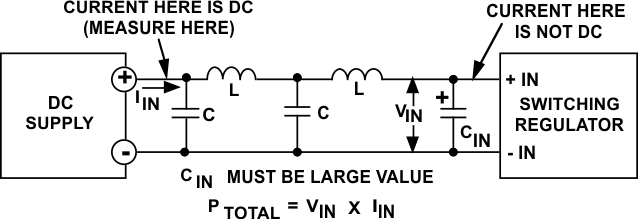SNVA559C September 2012 – February 2019 LM2574 , LM2575-N , LM2575HV , LM2576 , LM2576HV , LM2577
-
Switching regulator fundamentals
- Trademarks
- 1 Switching Fundamentals
- 2 Switching Converter Topologies
- 3 Application Hints for Switching Regulators
- 4 Application Circuits
- 5 References and Related Products
- Revision History
3.5 Measuring Regulator Efficiency of DC/DC Converters
The efficiency (η) of a switching regulator is defined as:
In determining converter efficiency, the first thing that must be measured is the total consumed power (PTOTAL). Assuming a DC input voltage, PTOTAL is defined as the total power drawn from the source, which is equal to:
It must be noted that the input current value used in the calculation must be the average value of the waveform (the input current will not be DC or sinusoidal).
Because the total power dissipated must be constant from input to output, PTOTAL is also equal to the load power plus the internal regulator power losses:
Measuring (or calculating) the power to the load is very simple, because the output voltage and current are both DC. The load power is found by:
Measuring the input power drawn from the source is not simple. Although the input voltage to the regulator is DC, the current drawn at the input of a switching regulator is not. If a typical clip-on current meter is used to measure the input current, the taken data will be essentially meaningless.
The average input current to the regulator can be measured with reasonable accuracy by using a wide-bandwidth current probe connected to an oscilloscope.
The average value of input current can be closely estimated by drawing a horizontal line that divides the waveform in such a way that the area of the figure above the line will equal the missing area below the line (see Figure 22). In this way, the average current shown is equivalent to the value of DC current that would produce the same input power.
 Figure 22. Average Value of Typical Input Current Waveform
Figure 22. Average Value of Typical Input Current Waveform If more exact measurements are needed, it is possible to force the current in the line going to the input of the DC/DC converter to be DC by using an L-C filter between the power source and the input of the converter (see Figure 23).
 Figure 23. L-C Filter Used in DC Input Current Measurement
Figure 23. L-C Filter Used in DC Input Current Measurement If the L-C filter components are adequate, the current coming from the output of the DC power supply will be DC current (with no high-frequency switching component) which means it can be accurately measured with a cheap clip-on ammeter and digital volt meter. It is essential that a large, low-ESR capacitor be placed at CIN to support the input of the switching converter. The L-C filter that the converter sees looking back into the source presents a high impedance for switching current, which means CIN is necessary to provide the switching current required at the input of the converter.